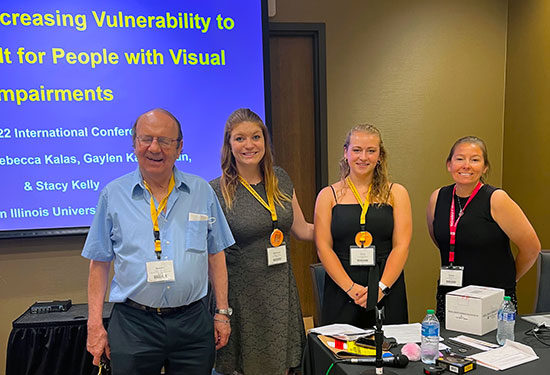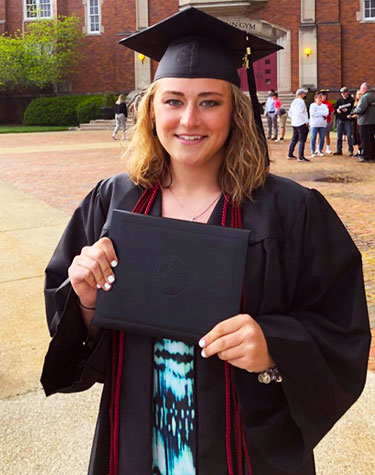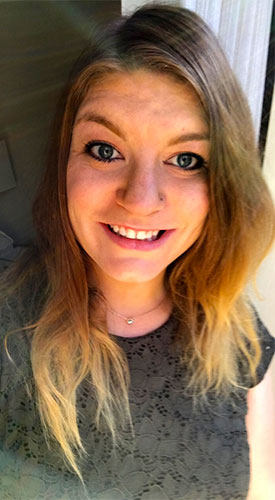
Gaylen Kapperman, Rebecca Kalas, Carly Spitz and Stacy Kelly
Gaylen Kapperman has attended countless professional conferences during his nearly half-century in academia.
But the professor emeritus in the Department of Special and Early Education’s Visual Disabilities program is hard-pressed to remember a meeting room fuller than the one he encountered this summer in St. Louis.
Presenting that Saturday at the biennial gathering of the Association for Education and Rehabilitation (AER) of the Blind and Visually Impaired?
NIU graduate students Carly Spitz and Rebecca Kalas, joined by Professor Stacy Kelly and Kapperman himself.
“We had standing-room-only. All the chairs were filled,” Kapperman says. “It was the best presentation at the conference – there’s no question in my mind – and it was one of the very best presentations I’ve ever been involved in. We’re very proud of them.”
Kelly confirms that assessment.
“I’ve been part of dozens and dozens and dozens of professional presentations locally, regionally, nationally and internationally over the years, and this was the very best professional presentation I’ve ever been a part of. It was just so spot-on in terms of timeliness of the topic and how well the audience received it,” Kelly says.

Stacy Kelly
“And I take no credit for the presentation; it was all our graduate students. I was simply a mentor and a co-presenter with them,” she adds. “There were people seated in the aisles, and there were many people standing at the back of the room and a couple dozen or so finding their way into the aisles.”
Titled “Methods for Decreasing Vulnerability to Sexual Assault for People with Visual Impairments,” the presentation included demonstrations of teachable self-defense techniques as well as precautions to improve personal safety and, if necessary, ways to help law enforcement.
Devices on display included tasers – “Everyone in the crowd was pretty excited about that,” Kalas says – and audio-enabled “SOS” technology while some of the tough-but-honest talk covered the investigative necessity of rape kits.
“People thought that was really important, even for sighted people, to go over,” Kalas says.
“We wanted to break that stigma and that fear of reporting because, unfortunately, it’s a reality that we live in,” she adds. “We just want to help educate and to make it a little less scary because people fear the unknown, so we can try to take the fear out of things and, hopefully, the reporting rate goes up.”
Spitz shares that hope.
“It’s a topic that a lot of people are scared to touch because it can be touchy and sensitive,” she says. “In terms of topics at the conference, it was definitely not presented on before – and it was something relevant to every person, let alone every woman, let alone every woman with a visual impairment.”

Carly Spitz
The M.S.Ed. student from Buffalo, N.Y., is observing the practical nature of relatively simple safety tips in her internship.
“We’re learning to teach all of our students that when they call an Uber, or any kind of transit, that they ask, ‘Who are you here for?’ and not, ‘Are you here for Carly Spitz?’ because anyone can say, ‘Yes,’ ” she says. “We’re trying to create this knowledge in people so that they know they don’t have to just wander about hoping that nothing ever happens. They can take precautions and, for the community of people with visual impairments, it’s a big deal.”
Indeed, Kapperman says.
Research shows that women with disabilities “are at the highest risk for sexual assault, and obviously women who are blind are included in that group,” Kapperman says.
The numbers are staggering: According to a 2001 study cited in the NIU presentation, 75% of people with visual impairments have been, or will be, assaulted in their lifetimes – 15 times the rate for the general population.
“One of the reasons that they’re chosen is because they’re blind,” Kapperman says, “and that the offenders think that they’re safe from identification, which is, in fact, the case.”
However, he says of a vital point made during the presentation, that safety is only visual: Self-defense techniques demonstrated by Kalas and Spitz included ways to collect DNA samples that can help police.
“This is an under-explored area of research in our field,” says Kelly, who took notes on the audience questions as ideas for future study. “People told me, ‘Oh my gosh, I wish I had this information a long time ago.’ ”
Spitz and Kalas attribute some of the success of their talk to their own attendance at several other presentations during the opening three days of the conference.

Carly Spitz and Rebecca Kalas
Their genuine excitement for the topic also helped, of course.
“It was a great experience because everybody was so encouraging of us. Right off the bat, when we started presenting, people were firing good questions at us and being supportive,” Spitz says. “It felt more like a conversation, telling people about everything that we were researching.
“We became so passionate about the topic and what we were telling people, and we’re not even in the career yet,” agrees Kalas, who grew up in suburban McHenry. “Dr. Kapperman keeps forwarding us emails that he got from people who attended the conference, and our presentation specifically, saying ‘This is such a great idea. Can you send me more resources? Can I be involved in the research?’ It was just great to feel like we did something and got our names out there. We’re going to be job-hunting soon.”
Conference attendance is a hallmark of NIU’s program, which was established in 1964.
Students on the trip also included Allison Cole, Kaitlyn Costello, Mandi Hetzel, Teresa Lopez, Alana Rybak, Taurus Smith, Tina Sutton and Monica Vandeven, all of whom joined faculty members Kelly, Kapperman, Molly Pasley, William Penrod and Sue Dalton.
Pasley, assistant professor in the Visual Disabilities program, says the clearly engaged Huskies “were just drinking it all in” while their future professional colleagues “were excited to have them there.”
“One of the valuable things for them is to see how the organization works. It also provides them the opportunity to learn more about professional development opportunities in our field,” Pasley says.
“Illinois is fortunate to have a really robust state chapter, so if our graduate students decide to stay in Illinois, they’ll have access to an annual conference,” she says.

Ten students in the College of Education’s program in visual disabilities attended the AER conference in St. Louis.
“If they decide to move out of state, they may not have as many opportunities for field-specific professional development, so AER is just another opportunity to gain that,” she adds, “along with the opportunity to network with professionals who are coming from not just all over the country but from all over the world.”
She saw great camaraderie among the students, who found seats at each other’s research talks to cheer them on. “I also had a session,” Pasley says, “and quite a few of them attended mine as well. It was really nice to talk to them about what they were finding value in at the conference and what they were enjoying.”
Kapperman, who came to NIU in 1974, says taking students to conferences “imbues them with the attitude of being a real professional.”
“That shows them importance of continuing to attend conferences to keep your skills up to date, to talk with others in your profession, to exchange information and ideas to keep your interest up in what you’re doing in providing the latest techniques that have been developed for your work with the blind youngsters for whom you have responsibility,” he says.
Even preparing the research to share at such events can pay dividends, he adds.
“Carly and Rebecca and Stacy and I have developed a manuscript that we have submitted for publication, and they will be included as co-authors on that,” Kapperman says.
“If it’s published, and I’m pretty sure it will be, these young women will be published authors. We’ve had a lot of students through they years who, by the time they graduate, or shortly after they graduate, are published authors. You can’t find another program in the nation that does that with master’s degree students.”

Rebecca Kalas
That sounds good to Spitz and Kalas.
Kalas, who holds a bachelor’s degree in Family and Consumer Sciences with a focus on family services, is happy with her choice of NIU – a recommendation from her aunt, a social worker in Illinois.
“So far, it’s been wonderful,” says Kalas, who is currently interning at the Lighthouse Center for Vital Living in Duluth, Minn., and will graduate next May.
“The professors are so knowledgeable – they know so much – and, not only that, they’re passionate. Dr. Kelly’s energy is unbeatable, and it makes you excited to learn,” she adds.
“That’s the kind of energy I try to surround myself with, and everyone in this program has just gotten me so excited about this field. I feel like I’m very prepared because the things I’ve learned, and the scenarios and the homework they’ve given us, has a purpose. Nothing they’ve given us did I question, ‘What is the purpose of doing this?’ It all had a meaning.”
Spitz, whose undergraduate program was Animal Studies, was drawn to a master’s degree by drawing a line between guide dogs and visual disabilities. She’s always been interested in the “helping” professions and grew up volunteering at different therapeutic riding organizations.
“This was kind of a path I stumbled upon, and it just fit,” says Spitz, who found NIU through Google searches and “very compelling” conversations with Kelly.

What she doesn’t know quite yet is how she’ll apply her degree.
“It’s hard because there are so many different things you can do, and I’d love to continue doing some research,” Spitz says. “Overall, I just want to touch as many lives as I can, create an impact where I can and see how far that will take me.”
